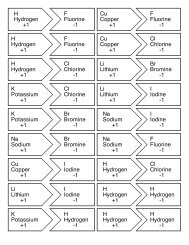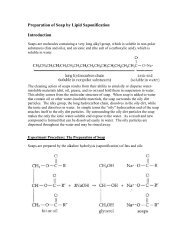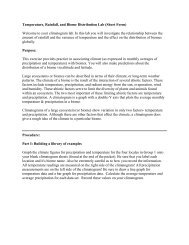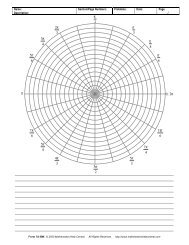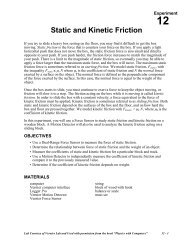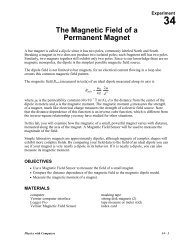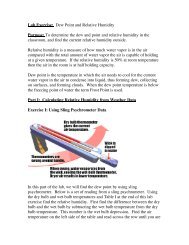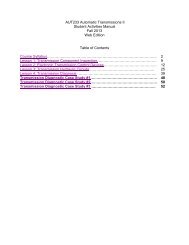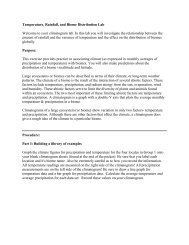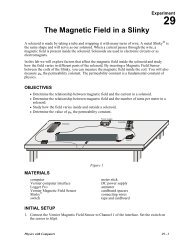30 Pressure and Volume Web Ver I - Faculty Webs
30 Pressure and Volume Web Ver I - Faculty Webs
30 Pressure and Volume Web Ver I - Faculty Webs
Create successful ePaper yourself
Turn your PDF publications into a flip-book with our unique Google optimized e-Paper software.
Computer <strong>30</strong><br />
6. Do gas pressure <strong>and</strong> volume vary directly or inversely? Explain.<br />
7. Write an equation to express the relationship between gas pressure <strong>and</strong> volume. Use the<br />
symbols P, V, <strong>and</strong> k.<br />
EXTENSIONS<br />
1. To confirm that an inverse relationship exists between pressure <strong>and</strong> volume, a graph of<br />
pressure versus the reciprocal of volume (1/volume or volume -1 ) may also be plotted. To do<br />
this using Logger Pro, it is necessary to create a new column of data, reciprocal of volume,<br />
based on your original volume data.<br />
a. Choose New Calculated Column from the Data menu.<br />
b. Enter “1/<strong>Volume</strong>.” as the Name, “1/V” as the Short Name, <strong>and</strong> “1/mL” as the Unit.<br />
c. Enter the correct formula for the column, (1/volume) into the Equation edit box. Type in 1<br />
<strong>and</strong> /. Then select “<strong>Volume</strong>” from the Variables list. In the Equation edit box, you should<br />
now see displayed: 1/“<strong>Volume</strong>”. Click Done.<br />
d. Click on the horizontal-axis label, select “1/<strong>Volume</strong>” to be displayed, <strong>and</strong> click .<br />
Make a best-fit curve.<br />
e. Click the Curve Fit button, .<br />
f. Choose Variable Power from the list at the lower left. Type 1 in the power edit box. Click<br />
.<br />
g. Click .<br />
If the relationship between P <strong>and</strong> V is an inverse relationship, the plot of P vs. 1/V should be<br />
direct; that is, the curve should be linear <strong>and</strong> pass through (or near) your data points.<br />
Examine your graph to see if this is true for your data.<br />
(Optional) Print the graph of P vs. 1/V.<br />
2. Repeat the experiment using a pure, noncorrosive gas, such as oxygen, butane, or carbon<br />
dioxide. Compare the results with your results for air.<br />
<strong>30</strong> - 4 Physical Science with <strong>Ver</strong>nier




